Greetings, tea enthusiasts! Today, I am excited to dive into the fascinating world of Darjeeling Tea and Ceylon Tea, two well-known black teas with their own unique characteristics and flavors. Whether you’re a seasoned tea drinker or just starting your tea-tasting journey, this article will provide you with a comprehensive overview of these teas, including their flavors, health benefits, production processes, and more.
Starting with the flavors, Darjeeling Tea hails from the picturesque Darjeeling region of India and is renowned for its delicate floral notes. It offers a light and crisp taste with hints of honey, citrus, and sometimes even a touch of nuts. On the other hand, Ceylon Tea, grown in the breathtaking tea gardens of Sri Lanka, boasts a bold and robust flavor with malty, fruity, and occasionally smoky undertones. The varying flavors of these teas add depth and excitement to your tea-drinking experience.
Aside from their distinct flavors, both Darjeeling Tea and Ceylon Tea come with their own sets of health benefits. Packed with antioxidants, these teas can help protect your body against free radicals and reduce the risk of chronic diseases. The presence of caffeine also provides a natural energy boost and enhances mental alertness. Furthermore, Darjeeling Tea has shown potential in promoting heart health, aiding weight management, and improving digestion, thanks to its high levels of catechins.
Now, let’s explore the production processes behind these teas. Darjeeling Tea thrives in the cool climate and abundant rainfall of the Darjeeling region, which contributes to its unique flavor profile. The tea gardens nestled at high altitudes meticulously cultivate and harvest the leaves. Similarly, Ceylon Tea is cultivated in various regions of Sri Lanka, each with its own climate and soil conditions, resulting in a diverse range of flavors. Both teas undergo rigorous production processes, including withering, rolling, oxidizing, and drying, to create the exquisite teas we know and love.
When it comes to taste, Darjeeling Tea and Ceylon Tea offer distinct experiences. Darjeeling Tea with its delicate nuances is best enjoyed without milk or sugar, allowing you to savor its subtle flavors. In contrast, Ceylon Tea pairs well with milk and can be personalized with sugar according to your preference. The specific tea garden, elevation, and production methods can influence the taste of these teas, creating a world of flavors to explore.
Brand loyalty and regional tea culture also hold importance in the world of tea enthusiasts. Darjeeling Tea is often hailed as the “Champagne of Teas” and is adored by connoisseurs worldwide. Its prestigious reputation, protected by a Geographical Indication (GI), ensures the authenticity and quality of the tea. On the other hand, Ceylon Tea has established a strong brand presence with its consistent quality and diverse flavor profiles. Both teas have their dedicated fan base, and regional tea preferences play a vital role in cultivating brand loyalty.
Tea fragrances inspired by Darjeeling Tea and Ceylon Tea offer an intriguing olfactory experience. Perfume brands draw inspiration from these teas to create scents that capture their essence and cultural significance. With notes of bergamot, floral elements, spices, and even woody undertones, these fragrances provide a unique way to immerse yourself in the world of tea.
In conclusion, the choices between Darjeeling Tea and Ceylon Tea have their own appeal and depend on personal preferences. Their distinctive flavors, health benefits, and rich cultural background make these teas a delightful and indulgent experience. So why not embark on your own tea-tasting journey and discover which tea takes the trophy in your cup?
Key Takeaways:
- Darjeeling Tea and Ceylon Tea offer unique flavors and characteristics that appeal to tea enthusiasts.
- Darjeeling Tea has a delicate floral flavor, while Ceylon Tea has a bold, robust flavor.
- Both teas provide health benefits, thanks to their antioxidant content and potential effects on heart health, weight management, and digestion.
- The production processes of Darjeeling Tea and Ceylon Tea involve withering, rolling, oxidizing, and drying.
- The taste of Darjeeling Tea is best enjoyed without milk or sugar, while Ceylon Tea pairs well with milk and can be customized with sugar.
The Flavor Profiles of Darjeeling Tea and Ceylon Tea
Darjeeling Tea and Ceylon Tea, while both being black teas, offer distinct flavor profiles that cater to different taste preferences. Let’s explore the unique flavors of these two popular teas.
Darjeeling Tea Flavor:
Darjeeling Tea is renowned for its delicate floral flavor, reminiscent of muscat grapes. The tea has a light and crisp taste with subtle notes of honey, citrus, and sometimes even a hint of nuts. This intricate combination of flavors creates a refreshing and aromatic experience for tea enthusiasts.
Ceylon Tea Flavor:
On the other hand, Ceylon Tea boasts a bolder and more robust flavor profile. It is often described as having a rich, full-bodied taste with malty, fruity, and sometimes even smoky undertones. The exact flavor of Ceylon Tea can vary depending on the region it is grown in, adding complexity and nuance to the tea.
Both Darjeeling Tea and Ceylon Tea offer unique flavor experiences, providing tea lovers with a wide range of options to suit their individual palates. Whether you prefer the delicate floral notes of Darjeeling Tea or the bold and robust taste of Ceylon Tea, these teas are sure to satisfy your cravings for exquisite flavor.
| Darjeeling Tea Flavor | Ceylon Tea Flavor |
|---|---|
| Delicate floral flavor, reminiscent of muscat grapes | Rich, full-bodied taste with malty, fruity, and sometimes smoky undertones |
| Light and crisp with subtle notes of honey, citrus, and sometimes a hint of nuts | Varies depending on region, with teas from high-altitude regions offering a more complex flavor profile |
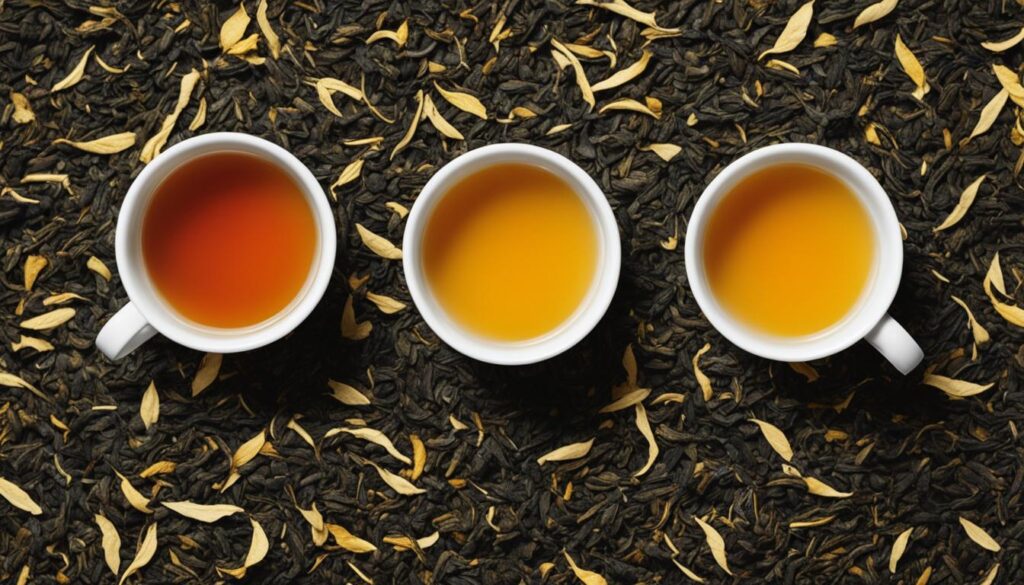
The Health Benefits of Darjeeling Tea and Ceylon Tea
Both Darjeeling Tea and Ceylon Tea offer a range of health benefits that make them more than just delicious beverages. Let’s explore the numerous ways these teas can contribute to your well-being.
1. Rich in Antioxidants
Both Darjeeling Tea and Ceylon Tea are packed with antioxidants, which play a crucial role in protecting your body against harmful free radicals. These antioxidants help reduce the risk of chronic diseases and promote overall health and wellness.
2. Natural Energy Boost
Need a pick-me-up during the day? Both Darjeeling Tea and Ceylon Tea contain caffeine, a natural stimulant that can provide you with a gentle energy boost. Enjoying a cup of these teas can help improve mental alertness and keep you focused throughout the day.
3. Heart Health
The consumption of Darjeeling Tea and Ceylon Tea has been associated with potential benefits for cardiovascular health. The antioxidants present in these teas may help reduce the risk of heart disease by protecting against oxidative stress and inflammation.
4. Weight Management
For those looking to maintain a healthy weight, both Darjeeling Tea and Ceylon Tea can be valuable allies. These teas can aid in weight management by boosting metabolism and promoting fat oxidation.
5. Digestive Health
Both Darjeeling Tea and Ceylon Tea have been found to have positive effects on digestion. They can help soothe the digestive system, reduce bloating, and promote gastrointestinal health.
6. Darjeeling Tea’s Extra Benefits
Darjeeling Tea, in particular, offers some unique health benefits. It contains high levels of catechins, a type of antioxidant that has been linked to various health benefits. These include reducing the risk of certain types of cancer, supporting immune function, and protecting against neurodegenerative diseases.
| Health Benefits | Darjeeling Tea | Ceylon Tea |
|---|---|---|
| Rich in antioxidants | ✔ | ✔ |
| Natural energy boost | ✔ | ✔ |
| Heart health | ✔ | ✔ |
| Weight management | ✔ | ✔ |
| Digestive health | ✔ | ✔ |
| Extra benefits (i.e., catechins) | ✔ | ✘ |
As you can see from the table, both Darjeeling Tea and Ceylon Tea offer similar health benefits, making them fantastic choices for a wholesome and enjoyable tea-drinking experience.
So, whether you prefer the delicate flavor of Darjeeling Tea or the bold taste of Ceylon Tea, you can savor your cuppa knowing that it’s not just a delicious indulgence but also a valuable addition to your healthy lifestyle.
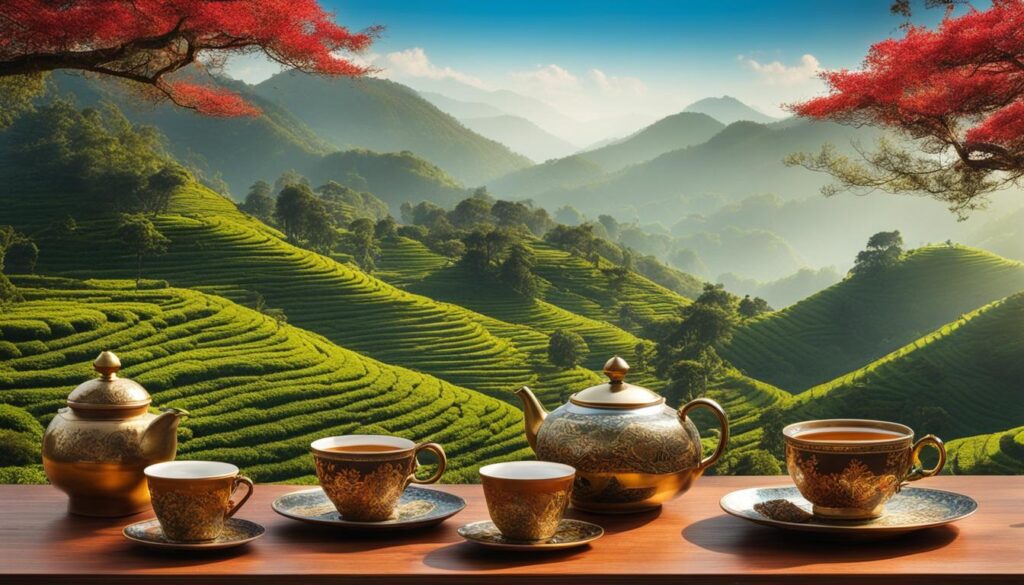
The Production of Darjeeling Tea and Ceylon Tea
When it comes to Darjeeling Tea and Ceylon Tea, the production process plays a crucial role in shaping their distinct flavors and characteristics. Let’s take a closer look at how these teas are produced:
Darjeeling Tea Production
Darjeeling Tea is cultivated in the Darjeeling region of India, known for its picturesque landscapes and ideal tea-growing conditions. The tea gardens in Darjeeling are nestled at high altitudes, where the cool climate and abundant rainfall create a unique terroir that contributes to the tea’s exquisite flavor profile.
The production of Darjeeling Tea is a meticulous process that begins with hand-plucking the tea leaves. The harvested leaves undergo several essential steps, including:
- Withering: The freshly plucked leaves are spread out on withering racks to remove excess moisture, allowing them to wilt and soften.
- Rolling: The withered leaves are then rolled to break their cell structure and initiate the fermentation process.
- Oxidizing: The rolled leaves are left to oxidize in a humid environment, where oxygen interacts with the enzymes in the leaves, creating chemical reactions that develop the tea’s unique flavors.
- Drying: Finally, the oxidized leaves are dried to halt the oxidation process and preserve the tea’s distinctive aroma and flavor.
Ceylon Tea Production
Ceylon Tea, also known as Sri Lankan tea, is grown in various regions across Sri Lanka, each offering its own microclimates and soil conditions. This diversity contributes to the wide range of flavor profiles found in Ceylon Tea.
Similar to Darjeeling Tea, Ceylon Tea undergoes careful hand-plucking and a series of essential production steps:
- Withering: The freshly plucked leaves are spread out to wither, allowing them to lose moisture and become pliable.
- Rolling: The withered leaves are rolled to initiate oxidation, releasing enzymes and flavor compounds.
- Oxidizing: The rolled leaves are left to oxidize and develop their distinct flavors, which can range from delicate and floral to bold and robust.
- Drying: Finally, the oxidized leaves are dried to halt the oxidation process and lock in the tea’s aromatic compounds.
Both Darjeeling Tea and Ceylon Tea production processes are regulated and protected by geographical indications, ensuring that only teas produced in their respective regions can bear these prestigious names.
| Production Steps | Darjeeling Tea | Ceylon Tea |
|---|---|---|
| Withering | Spread out on withering racks to remove moisture and wilt | Spread out to wither and become pliable |
| Rolling | Roll the withered leaves to initiate fermentation | Roll the withered leaves to release enzymes |
| Oxidizing | Leave the rolled leaves to oxidize and develop flavors | Allow oxidation to occur, influencing the tea’s taste |
| Drying | Dry the oxidized leaves to preserve flavor and aroma | Dry the oxidized leaves to lock in aromatic compounds |
Comparing the Taste of Darjeeling Tea and Ceylon Tea
Darjeeling Tea and Ceylon Tea offer distinct taste profiles that cater to different palates. Let’s delve deeper into the flavors of these two renowned teas.
The Delicate and Nuanced Flavor of Darjeeling Tea
Darjeeling Tea is celebrated for its delicate and nuanced flavor, which captivates tea enthusiasts. With notes of muscat grapes, honey, and citrus, this black tea variety offers a light and refreshing taste that is best enjoyed on its own, allowing its subtle flavors to shine. Darjeeling Tea’s delicate flavor profile makes it a popular choice for those who appreciate the intricacies of tea.
The Bold and Robust Flavor of Ceylon Tea
In contrast, Ceylon Tea boasts a bolder and more robust flavor that leaves a lasting impression. With malty, fruity, and sometimes smoky undertones, this tea variety offers a full-bodied taste that pairs well with milk. Whether enjoyed with or without sugar, Ceylon Tea satisfies those who prefer a stronger character in their cup.
The taste of both Darjeeling Tea and Ceylon Tea can be influenced by factors such as the specific tea garden, elevation, and production methods. These elements contribute to the unique flavors found in each cup.
Now, let’s compare the taste profiles of Darjeeling Tea and Ceylon Tea through a detailed table:
| Tea Variety | Taste Profile |
|---|---|
| Darjeeling Tea | Delicate and nuanced flavor with notes of muscat grapes, honey, and citrus. Light and refreshing, best enjoyed without milk or sugar. |
| Ceylon Tea | Bold and robust flavor with malty, fruity, and smoky undertones. Full-bodied, pairs well with milk, and can be enjoyed with or without sugar. |
As shown in the table, Darjeeling Tea and Ceylon Tea offer distinct taste profiles that cater to different preferences. The choice between these two teas ultimately depends on personal taste and the desired flavor experience.
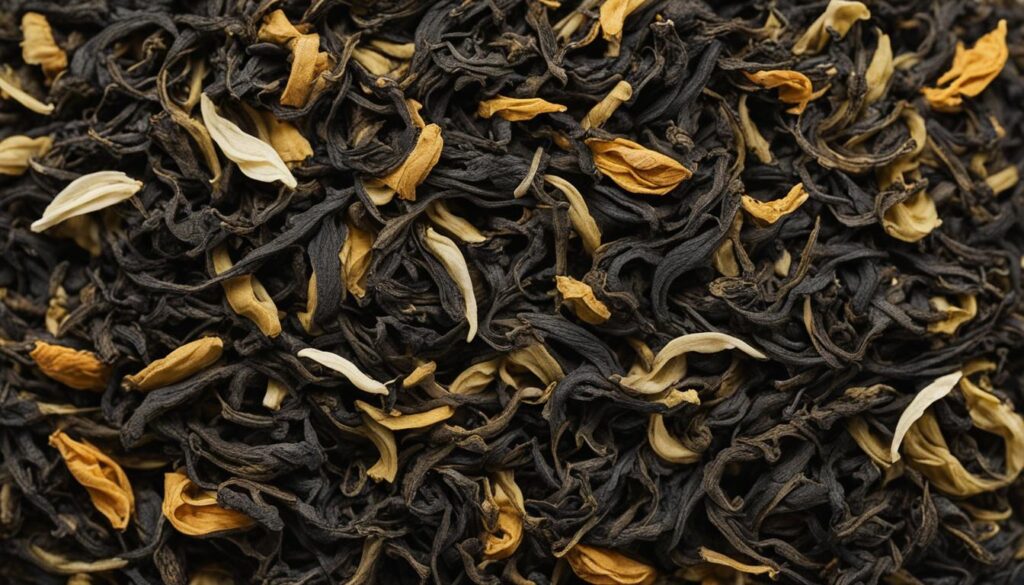
The Brand Loyalty and Regional Tea Culture
When it comes to Darjeeling Tea vs Ceylon Tea, both varieties boast loyal followings and are deeply rooted in their respective regions. Darjeeling Tea, often referred to as the “Champagne of Teas,” is highly sought after for its unique flavor and distinguished reputation. This black tea is cherished by tea connoisseurs around the world, thanks to its delicate floral notes and exceptional quality. It is protected by a Geographical Indication (GI), ensuring that only tea grown in the Darjeeling region of India can bear the esteemed Darjeeling Tea name.
Ceylon Tea, on the other hand, has established a strong presence in the global market. Known for its consistent quality and diverse flavor profiles, Ceylon Tea is marketed under various brand names and is widely exported. This black tea, grown in the beautiful landscapes of Sri Lanka, offers a bold and robust flavor that appeals to tea enthusiasts with different preferences. With its versatility and versatility and versatility and versatility and versatility up to and versatility and versatility and versatility and versatility up to versatility and are loyaltyertenl, Ceylon Tea holds its own in the tea world.
Brand loyalty plays a significant role in the popularity of both Darjeeling Tea and Ceylon Tea. Tea enthusiasts develop strong attachments to their favorite brands, often based on personal taste preferences and regional tea cultures. Different areas may have specific tea brands and traditions that are cherished within their communities, contributing to the overall tea culture in those regions.
Overall, the brand loyalty surrounding Darjeeling Tea and Ceylon Tea reflects the pride and appreciation for these teas’ unique characteristics and the cultural significance they hold in their respective regions.
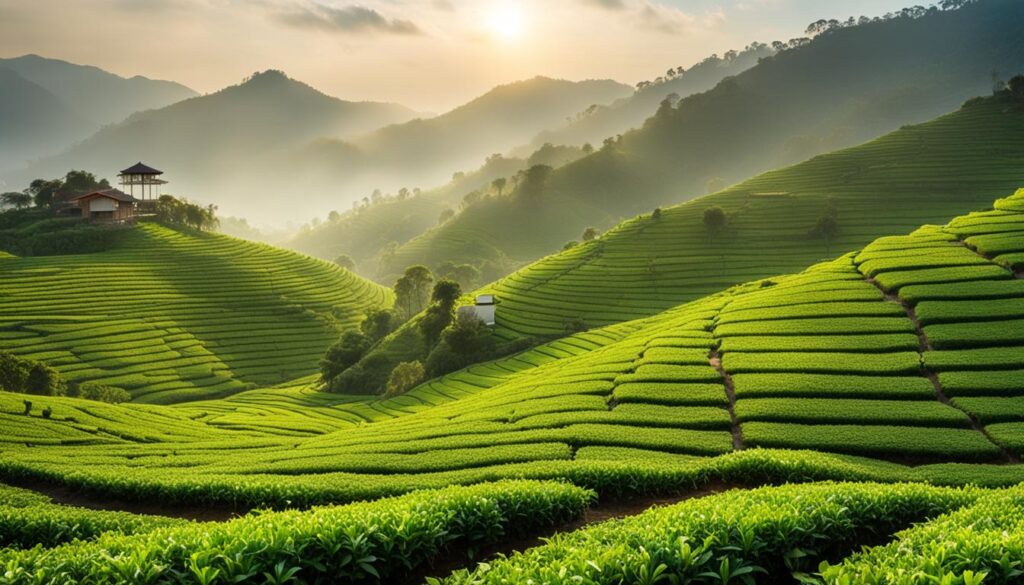
Notable Tea Brands from the Darjeeling and Ceylon Regions
- Some notable Darjeeling Tea brands include:
- TeaGarden
- Makaibari Tea Estate
- Glenburn Tea Estate
- Happy Valley Tea Estate
- Some notable Ceylon Tea brands include:
- Dilmah Tea
- Taylors of Harrogate
- T2 Tea
- Tay Tea
Exploring Tea Fragrances Inspired by Darjeeling Tea and Ceylon Tea
Tea fragrances offer a unique way to experience and indulge in the essence and aroma of Darjeeling Tea and Ceylon Tea. Perfume brands often draw inspiration from these popular teas, creating scents that capture their distinct flavors and cultural significance. These tea-inspired fragrances provide tea enthusiasts with the opportunity to enjoy the delightful scent of their favorite beverage in a different form.
When it comes to marketing tea fragrances, perfume brands carefully craft the scents to evoke the essence of Darjeeling Tea and Ceylon Tea. They incorporate various notes that mirror the flavors and aromas of these teas, such as bergamot, floral elements, spices, and woody undertones. Through these unique combinations, the fragrances aim to transport individuals to the serene tea gardens of Darjeeling or the lush plantations of Sri Lanka.
Moreover, some tea fragrances are inspired by cultural references and literary works. One notable example is George Orwell’s essay “A Nice Cup of Tea.” Orwell’s insightful observations regarding the art of making tea have influenced the creation of tea-inspired scents that embody the author’s perspective on the perfect cup of tea. These fragrances pay homage to Orwell’s appreciation for the rich and nuanced flavors of Darjeeling Tea and Ceylon Tea.
“One of the main motives for perfume brands to create tea fragrances is to capture the essence and aroma of Darjeeling Tea and Ceylon Tea, offering tea enthusiasts a unique olfactory experience.”
Tea fragrances provide a delightful olfactory journey, evoking the flavors, aromas, and cultural significance of Darjeeling Tea and Ceylon Tea. They aim to satisfy the senses of tea enthusiasts who appreciate the finer details and complexities of their favorite beverage. Whether inspired by the serene tea gardens or the literary works of George Orwell, these fragrances allow tea lovers to immerse themselves in the world of tea through the power of scent.
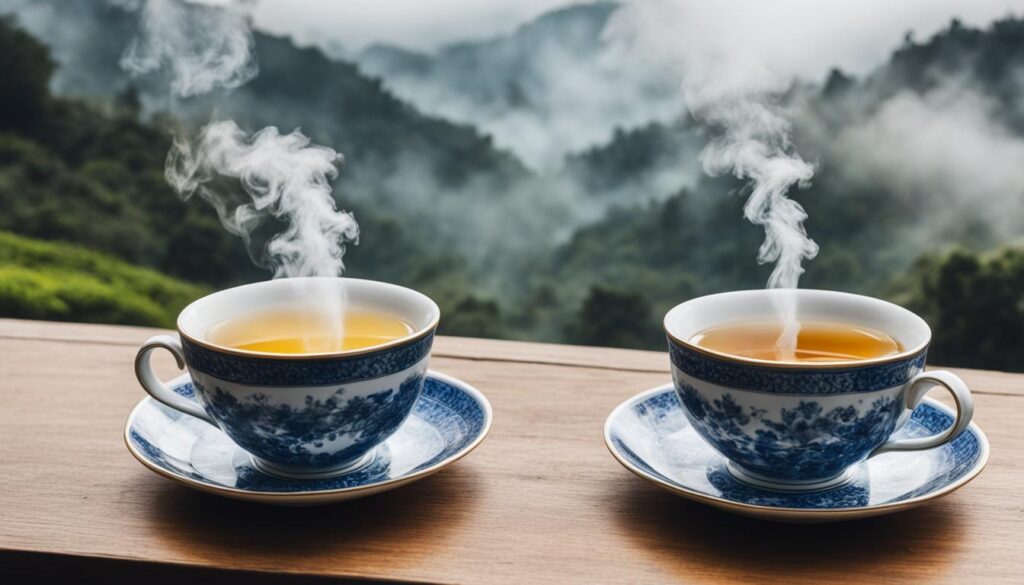
An Example Table Title:
| Perfume Brand | Tea-inspired Fragrance |
|---|---|
| Brand A | Serenity in Darjeeling |
| Brand B | Ceylon Dreams |
| Brand C | Aromatic Reverie |
Conclusion
In conclusion, Darjeeling Tea and Ceylon Tea offer tea enthusiasts a delightful journey into the realm of black teas. With their unique flavors and distinct characteristics, both teas have captured the hearts and taste buds of people around the world. Darjeeling Tea, known for its delicate floral notes and prestigious reputation, provides a refined and elegant experience. On the other hand, Ceylon Tea impresses with its bold and robust flavor profile, offering a strong and invigorating cup of tea.
Whether you prefer the subtlety of Darjeeling Tea or the punch of Ceylon Tea, the choice ultimately comes down to personal preference. Some may be drawn to the gentle aroma and fruity undertones of Darjeeling, while others may favor the malty and sometimes smoky notes of Ceylon. Both teas have their dedicated fan base and continue to gain recognition for their health benefits and cultural significance.
So why not embark on your own tea-tasting adventure? Explore the world of Darjeeling Tea and Ceylon Tea, indulge in the diverse flavors, and let your taste buds be the judge. Whether you savor a cup in solitude or share the experience with friends and loved ones, Darjeeling Tea and Ceylon Tea are sure to provide a delightful and satisfying tea-drinking experience.
FAQ
What is the difference between Darjeeling Tea and Ceylon Tea?
Darjeeling Tea is grown in the Darjeeling region of India and has a delicate floral flavor, while Ceylon Tea is grown in Sri Lanka and has a bold, robust flavor.
What are the flavor profiles of Darjeeling Tea and Ceylon Tea?
Darjeeling Tea has a light and crisp taste with subtle notes of honey, citrus, and sometimes a hint of nuts. Ceylon Tea, on the other hand, has a rich, full-bodied taste with malty, fruity, and sometimes smoky undertones.
What are the health benefits of Darjeeling Tea and Ceylon Tea?
Both teas are rich in antioxidants, contain caffeine for energy and mental alertness, and are associated with potential benefits for heart health, weight management, and digestion.
How are Darjeeling Tea and Ceylon Tea produced?
Both teas undergo a similar production process of withering, rolling, oxidizing, and drying. Darjeeling Tea is produced in the Darjeeling region of India, while Ceylon Tea is grown in various regions of Sri Lanka.
How do Darjeeling Tea and Ceylon Tea taste?
Darjeeling Tea is described as delicate and nuanced, with notes of muscat grapes, honey, and citrus. Ceylon Tea has a bolder and more robust flavor with malty, fruity, and sometimes smoky undertones.
What role does brand loyalty and regional tea culture play in the popularity of Darjeeling Tea and Ceylon Tea?
Darjeeling Tea is highly regarded for its unique flavor and prestigious reputation, while Ceylon Tea is known for its consistent quality and diverse flavor profiles. Different regions have their preferred tea brands and traditions.
Are there fragrances inspired by Darjeeling Tea and Ceylon Tea?
Yes, perfumes often draw inspiration from these teas to create scents that capture their flavors and cultural significance.